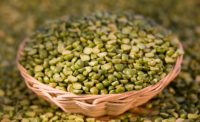Consumer interest in foods that support holistic health and well-being is increasing. According to the 2020 IFIC Food and Health Survey, over half of consumers report that healthfulness has more of an impact today versus 10 years ago on their food and beverage purchase decisions. In line with the nutrients considered the healthiest, consumers state they are trying to consume more fiber, whole grains and protein from plant-based sources.
This is translating into sales. According to IRI, Chicago, sales for bakery products featuring a protein claim rose 17 percent in 2019, and sales for snacks featuring a protein claim rose 11 percent. In its 2020 “State of the Bakery Industry” presentation, IRI shared that dollar sales of bakery products with high-fiber claims grew 15.1 percent versus year ago.
As snacking increases and replaces traditional meals, consumers are more mindful of their snack choices. The time of day can also influence the desire for nutritious food.
Paula Labine, marketing director, baking, milling and starch, ADM, Chicago, shares some key sights from ADM’s proprietary research, ADM OutsideVoice: “The research shows that morning dayparts are popular opportunities for food delivering sustained energy, satiety, and functional health benefits, while the afternoon and evening needs shift toward comfort, indulgence, and reward. Product developers have an opportunity to strengthen the nutritional profile of breakfast items like breads, cereals, and muffins with nutrient-dense ingredients such as plant protein, ancient grains, and fiber.”
Emerging ingredients
Consumers have a growing interest in gut health, and they are aware of the research that links gut health to overall well-being. This is driving new levels of ingredient innovation.
Cargill, Minneapolis, is breaking new ground with EpiCor, a whole-food fermentate. “It’s part of an emerging group of postbiotic ingredients, which are starting to catch consumers’ eye,” says Cashtyn Lovan, senior marketing associate, Cargill Health Technologies. “Backed by over 75 years of fermentation expertise, EpiCor is made through a natural, proprietary process that creates a unique fingerprint of metabolites. EpiCor is highly heat-stable, can handle varying pH levels, and has a three-year shelf life. It does have a savory flavor and brown coloring. However, when paired with the right food applications, these attributes can be easily masked or even enhance the flavor. EpiCor has been clinically shown to support the immune system and beneficially modulate the gut microbiota—giving nutrition bars and similar snacks the superpowers consumers often associate with fermented foods.” The company has created prototype applications such as chocolate bites and granola bars.
ADM recently introduced one of its first postbiotics, heat-treated BPL 1 (HT- BPL 1). Postbiotics have similar benefits as probiotics, but can be used in a wider range of applications. “ADM intentionally evolved our portfolio to provide a range of microbiome solutions that are suitable for virtually any application. Postbiotics are tolerant to heat and moisture and are generally better suited to baked goods than probiotics since they do not contain living microorganisms. ADM’s postbiotics are easy to add at any stage of formulation without risking damage to the postbiotic during processing. ADM’s postbiotic heat-treated BPL 1 (HT-BPL 1), is uniquely tolerant to high-temperature applications and other harsh processing conditions. HT- BPL1 makes it possible to add functional health and wellness benefits to a wide variety of food and beverage applications like baked goods and snacks,” notes Labine. BPL 1 is available as a live bacterial strain and in a heat-treated form.
Protein power
Parabel USA, Inc., Vero Beach, FL, has taken the water lentil plant and leveraging their patented technologies has transformed this plant into a unique high protein food product. Cecilia Wittbjer, vice president of marketing, describes the product: “LEINTEIN is made from water lentils. They are the world’s smallest flowering plant and grows on top of the water in our hydroponic ponds. LEINTEIN has higher levels of essential amino acids than other plant proteins, and it’s also highly digestible. This means that you don’t need to mix protein to get a complete amino acid profile. The protein concentrate also contains omega-3 and is a good source of vitamins and minerals. It also contains vitamin B12 which is not common from a plant source.”
Two formats are available. Green LENTEIN protein isolate imparts a green color and has been shown to work well in no-bake bars, power balls, and savory snacks such as tortilla chips and crackers. A neutral-colored LENTEIN isolate can be used for protein fortification and has a broader range of applications due to its neutral color. These products are also hypoallergenic and non-GMO.
COSUCRA Inc., Warcoing, Belgium, recently launched PISANE B9 pea protein, a unique and functional pea protein that is a complete protein having all nine essential amino acids. It is easy to disperse and can simply be added to the other dry ingredients. “PISANE B9 pea protein can be used at a very high level without much impact on the texture and taste. It can be applied alone or in combination with other types of protein. It can also be used for partial or full milk protein replacement in different types of recipes,” explains Frank Truong, general manager.
Troung notes the pea protein is helpful when developing gluten-free baked products. Adding up to 3 percent PISANE B9 pea protein provides several functional benefits:
- Increased loaf volume
- Softer bread crumb texture (slightly more elastic)
- Improved color and taste
- Delayed staling rate
There’s also a synergy between PISANE B9 pea protein and psyllium in reducing a bread’s crumb hardness without affecting loaf volume, notes Truong.
In addition to gluten-free baked products, Truong notes the pea protein works well in in bars, cookies, and extruded snacks.
ADM notes that eating to fuel the body with sustained energy is inspiring the growth of products featuring nutrient-dense ingredients like plant protein and ancient grains. The company’s proprietary research, ADM OutsideVoice, shows 39 percent of consumers are taking steps to proactively manage their energy. To address this need in the marketplace, the company recently introduced Arcon T textured pea proteins. These new ingredients can help improve the texture and density of baked products while simultaneously boosting protein levels, says Labine. “The Arcon T textured pea proteins have minimal impact on color and flavor, making them useful in applications like nutritional bars and cereals. ADM offers two forms of Arcon T textured pea protein—one that is a blend of pea protein and chickpea protein and another blends pea protein and navy beans. Both pea proteins are well suited for products where allergen-free and clean-label positioning is the target.”
Cargill shared key insights from its proprietary research suggesting that consumers are ready to see the same nutritional benefits from ingredients like protein and fiber in snack-oriented categories such as muffins, breads, crackers, breakfast biscuits, and cookies. The challenges with adding any nutritional ingredient is to not compromise the taste or texture. “Fortunately, today’s improved plant proteins offer neutral flavor profiles and improved functionality. PURIS pea protein, for example, comes from pea seed varieties specially selected to minimize the off-flavors normally attributed to pulses. Water management is another common challenge when working with proteins in baked goods. Proteins tend to hydrate and compete for water, increasing the density of the final product. To help prevent dryness, we’ve learned to allow time for proteins to hydrate,” shares Tim Christensen, certified master baker, R&D bakery applications.
Blue Diamond Almonds Global Ingredient Division, Sacramento, CA, sees protein claims as a differentiator for virtually any snack or bakery item positioned as healthier or better-for-you. The company shared recent data from Mintel, stating that 23 percent of U.S. bakery consumers consider high-protein claims important on baked goods. The company’s latest innovation, Almond Protein Powder, provide product developers with a new clean-tasting, plant-based protein. “Almond Protein Powder is approximately 45 percent protein, making one 30 gram serving a good source of protein. It is also an excellent source of biotin, phosphorous, copper, magnesium, and manganese, and a good source of fiber, calcium, potassium, zinc, and iron. It is often used within a protein blend to create products with complete amino acid profiles for optimal product development,” explains Laura Gerhard, director of strategy and marketing. It is well suited to use in nutrition and protein bars, and as part of an almond flour blend, contributing to fortified versions of bars, cookies, brownies, and other baked goods.
Sustainability is another area of ongoing interest. EverGrain Ingredients, St. Louis, creates sustainable, nutritious, functional ingredients with barley. “Barley ingredients represent attractive plant-based protein and fibers for health-conscious consumers looking to conserve land, save water, and lower their overall carbon footprint,” states Giacomo Cattaneo, global director. The company is launching two new ingredients: EverPro, a soluble protein isolate, and two EverVita protein and fiber ingredients. EverVitaPro has higher protein content (greater than 33 percent), in addition to fiber and can be labeled as “barley fiber and protein.” EverVita Fibra is a high-fiber (60 percent) product that easily integrates into any flour blend and appears as “barley fiber” on labels.
“Within the snack and bakery application categories, we’re proving benefits in pizza crusts, pastas, cakes, cookies, nutrition bars, bread, crackers, and more,” says Cattaneo. “Several of these application categories are not traditionally known for delivering nutritive benefits, but barley opens opportunities for them to differentiate without complex reformulations, improve the nutritional profile, maintain label-friendliness, and deliver on consumer demand.”
Meat-based proteins and chicken protein isolates are also good ways to add protein to products. “CHiKPRO contains the same nutrients as eating a piece of chicken. In addition to high-quality protein, it also has the nutrients (like zinc and iron, based on 100-gram serving) necessary to promote and maintain balanced nutrition, is rich in electrolytes, and has a 2:1 potassium/sodium ratio to support recovery and rehydration. These products offer a low-carb, low-fat, highly digestible protein option, as well. The key is finding the right amount to include in a recipe and understanding the ingredient interactions when working with other proteins and/or starches inherent to the bakery/snack system,” shares Ann Marie D. Craig, Ph.D., R&D director, IDF, Springfield, MO. These ingredients have a slightly savory flavor, are naturally allergen-free and gluten-free, and are available in a range of solubility levels. Applications where CHiKPRO has worked well include waffles, bagels, muffins, protein bars, baked cereals, and snack crisps.
Fortification with fiber
Consumer interest in organic products is increasing, creating a need for more organic ingredients. BENEO, Parsippany, NJ, recently launched Orafti Organic, building on the popularity of its natural chicory root fiber (inulin and oligofructose). “Orafti Organic enables manufacturers to now add organic prebiotic fiber to improve taste and texture, while also allowing for fat and sugar reduction,” says Steven Gumeny, product manager. As a prebiotic, Orafti Organic promotes digestive health by feeding and helping beneficial gut bacteria grow to support a balanced and healthy gut microbiome, he says. It also helps formulators reduce sugar, thereby reducing blood glucose response. This new ingredient can be used in the same applications as the traditional chicory root fiber, including a wide variety of baked goods.
BENEO also recently introduced a new organic waxy rice starch, Remyline O AX DR. “As this rice starch is a waxy type, it has no amylose and delivers better stability and less syneresis in the final product, which makes it easier to maintain stable texture throughout the shelf life,” says Gumeny. It has high digestibility and is hypoallergenic. It’s gluten-free and dairy-free, and offers a clean label.
Citri-Fi from Fiberstar, River Falls, WI, is an upcycled ingredient made from byproducts from the citrus juicing process. Citri-Fi provides both nutritional and functional benefits to a product. Citri-Fi products are excellent at maintaining freshness, keeping moisture retention in baked goods or snack foods so that they do not dry out over time, says Brock Lundberg, Ph.D., vice president of R&D and applications. “Additionally, this citrus fiber is an excellent natural emulsifier that is able to bind large amounts of both water and oil, which means relatively low usage rates are required for stabilization compared to other emulsifying ingredients. Because of these natural functionalities, Citri-Fi can be used to reduce egg and/or oil content while maintaining the full fat mouthfeel.”
Consumers’ interest in holistic health and well-being will only continue to grow. This will drive the need for the continued innovation for new ingredients, nutrients and product applications to meet this demand.




